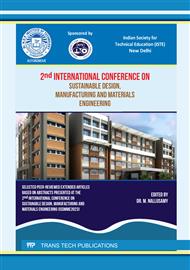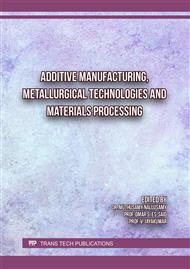[1]
Rui Fu, Shuiyuan Tang, Jiping Lu, Yinan Cui, Zixiang Li, Haorui Zhang, Tianqiu Xu, Zhuo Chen, Changmeng Liu, Hot-wire arc additive manufacturing of aluminum alloy with reduced porosity and high deposition rate, Materials & Design, 199 (2021) 1-13.
DOI: 10.1016/j.matdes.2020.109370
Google Scholar
[2]
P. Zhang, Z. Jia, H. Yan, Z. Yu, D. Wu, H. Shi, W. Lei, Effect of deposition rate on microstructure and mechanical properties of wire arc additive manufacturing of Ti-6Al-4V components, J. Cent. South Univ. 28 (2021)1100–1110.
DOI: 10.1007/s11771-021-4683-0
Google Scholar
[3]
N. Rodriguez, L. Vázquez, I. Huarte, E. Arruti, I. Tabernero, P. Alvarez, Wire and arc additive manufacturing: a comparison between CMT and Top TIG processes applied to stainless steel, Weld World, 62(2018) 1083–1096.
DOI: 10.1007/s40194-018-0606-6
Google Scholar
[4]
M. Cheepu, C.I. Lee, S.M. Cho, Microstructural characteristics of wire arc additive manufacturing with inconel 625 by super-TIG welding, Trans Indian Inst Met, 73 (2020) 1475-1479.
DOI: 10.1007/s12666-020-01915-x
Google Scholar
[5]
E. Aldalur, F. Veiga, A. Suárez, J. Bilbao, A. Lamikiz, Analysis of the wall geometry with different strategies for high deposition wire arc additive manufacturing of mild steel, Metals, 10 (2020) 1-18.
DOI: 10.3390/met10070892
Google Scholar
[6]
Q. Han, J. Gao, C. Han, G. Zhang, Y. Li. (2020). Experimental investigation on improving the deposition rate of gas metal arc-based additive manufacturing by auxiliary wire feeding method, Weld World, 65 (2021)35-45.
DOI: 10.1007/s40194-020-00994-0
Google Scholar
[7]
E. Brandl, V. Michailov, B. Viehweger, C. Leyens. Deposition of Ti–6Al– 4V using laser and wire, part I: microstructural properties of single beads, Surf Coat Technol, 206 (2011)1120–1129.
DOI: 10.1016/j.surfcoat.2011.07.095
Google Scholar
[8]
E. Tenuta, A. Nycz, M. Noakes, S. Simunovic, M.H.A. Piro, Material properties and mechanical behaviour of functionally graded steel produced by wire-arc additive manufacturing, Additive Manufacturing, 46 (2021), 1-36.
DOI: 10.1016/j.addma.2021.102175
Google Scholar
[9]
J. Kevin, J. Richard, Bridging additive manufacturing and sand casting: Utilizing foundry sand, Additive Manufacturing, 28, (2019) 649-660.
DOI: 10.1016/j.addma.2019.06.008
Google Scholar
[10]
S.H. Mok, G. Bi, J. Folkes, I. Pashby. Deposition of Ti–6Al–4V using a high power diode laser and wire, Part I: investigation on the process characteristics. Surf Coat Technol, 202 (2008)3933–3939.
DOI: 10.1016/j.surfcoat.2008.02.008
Google Scholar
[11]
Donghong Ding, Zengxi Pan, Dominic Cuiuri, Huijun Li, A multi-bead overlapping model for robotic wire and arc additive manufacturing (WAAM) Robot, Cim-Int Manuf. 31 (2015) 101-110.
DOI: 10.1016/j.rcim.2014.08.008
Google Scholar
[12]
Filippo Montevecchi, Niccolò Grossi, Hisataka Takagi, Antonio Scippa, Hiroyuki Sasahara, Gianni Campatelli, Cutting Forces Analysis in Additive Manufactured AISI H13 Alloy, Procedia CIRP, 46 (2016) 476-479.
DOI: 10.1016/j.procir.2016.04.034
Google Scholar
[13]
R. Raj Mohan, R. Venkatraman, S. Raghuraman, P. Manoj Kumar, Moti Lal Rinawa, Ram Subbiah, B. Arulmurugan, S. Rajkumar, Processing of Aluminium-Silicon Alloy with Metal Carbide as Reinforcement through Powder-Based Additive Manufacturing: A Critical Study, Scanning, 2022 (2022) 1-14.
DOI: 10.1155/2022/5610333
Google Scholar
[14]
C. Ramesh, P. Mohammed Tharwan, Manoj Kumar, Dawit Tafesse Gebreyohannes, Microstructural and Mechanical Characteristics of Pure-Cu/brass Dissimilar Joints Welded by Friction Stir Welding Using Various Process Parameters, Advances in Materials Science and Engineering, 2022 (2022) 1-10.
DOI: 10.1155/2022/2234352
Google Scholar
[15]
SP. Arunkumar, C. Prabha, Rajasekaran Saminathan, Jabril A. Khamaj, M. Viswanath, C. Kevin Paul Ivan, Ram Subbiah, P. Manoj Kumar, Taguchi optimization of metal inert gas (MIG) welding parameters to withstand high impact load for dissimilar weld joints, Materials Today: Proceedings,56(2022) 1411-1417.
DOI: 10.1016/j.matpr.2021.11.619
Google Scholar
[16]
S. Yaknesh, Mohammed Tharwan, Rajasekaran Saminathan, N. Rajamurugu, K. B. Prakash, undefined Ankit, Manoj Kumar Pasupathi, Atul Sarojwal, Dawit Tafesse Gebreyohannes, "Mechanical and Microstructural Investigation on AZ91B Mg Alloys with Tool Tilt Variation by Friction Stir Welding", Advances in Materials Science and Engineering, 2022 (2022)1-14.
DOI: 10.1155/2022/8311413
Google Scholar
[17]
M. Somasundaram, J.P. Kumar, Multi response optimization of EDM process parameters for biodegradable AZ31 magnesium alloy using TOPSIS and grey relational analysis. Sādhanā 47, (2022)1-14.
DOI: 10.1007/s12046-022-01908-0
Google Scholar



